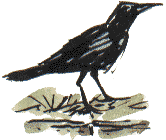 
Buff ErmineSaturday 3rd June 2000 TWO BUFF ERMINE MOTHS, Spilosoma lutea, shelter from the rain under the rim of the front door. I take one upstairs to draw in the studio and it 'plays dead' the whole time, an obliging model for me.
TWO BUFF ERMINE MOTHS, Spilosoma lutea, shelter from the rain under the rim of the front door. I take one upstairs to draw in the studio and it 'plays dead' the whole time, an obliging model for me.
In the the New Naturalist Moths, first published in 1955, E.B.Ford shows two 'normal' Buff Ermines, collected in Oxford and Huntingdonshire, alongside three blacker versions, collected in Yorkshire. This was before the Clean Air Act. I remember that trees and buildings looked blacker in those days. Ford explains that the blacker versions get their colouring from their inheritance of particular genes, which can come in two varieties or alleles (allele is from a Greek word which simply means 'one or the other', or rather 'one another'). Another form of blackening, melanism, is caused by the overproduction of melanin. Melanin is the dark brown pigment that is produced when we get sunburnt. In the 1950s the melanistic version of the Peppered Moth became more common in industrial areas. The theory was that any population of peppered moths always has a mixture of normal and melanistic individuals. In polluted areas the normal versions, sitting on soot-blackened tree trunks, were easily picked out by predators, leading to an increase the proportion of the better camouflaged melanistic variety in the population. Perhaps this is why Ford showed blackened specimens of the buff ermines from Yorkshire. If so our air quality must be getting better. I've never come across a blackened version of this moth and I've seen a dozen or more over the years.
On a visit to the Arts Mill gallery near the River Calder in Wakefield we see what we think is a Linnet emerge from the bush in the car park.
|